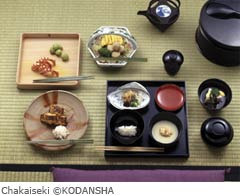Japanese cuisine involves the elegant presentation of delicate flavours and textures created from a refined sense of taste and varied seasonal ingredients. Using the maximising of awareness of seasonal elements as an art form, traditional Japanese cuisine is sensitive to even the subtle differences in taste between early and late spring. Serving dishes also play an important role. Changing with the seasons, they afford the cultured pleasure of choosing, for example, a flower pattern to reflect a sense of enjoyment from tableware used only in the flower°«s blooming season. |
 |
|
Copyright 2007 - Ministry of Foreign Affairs, Japan |
||










